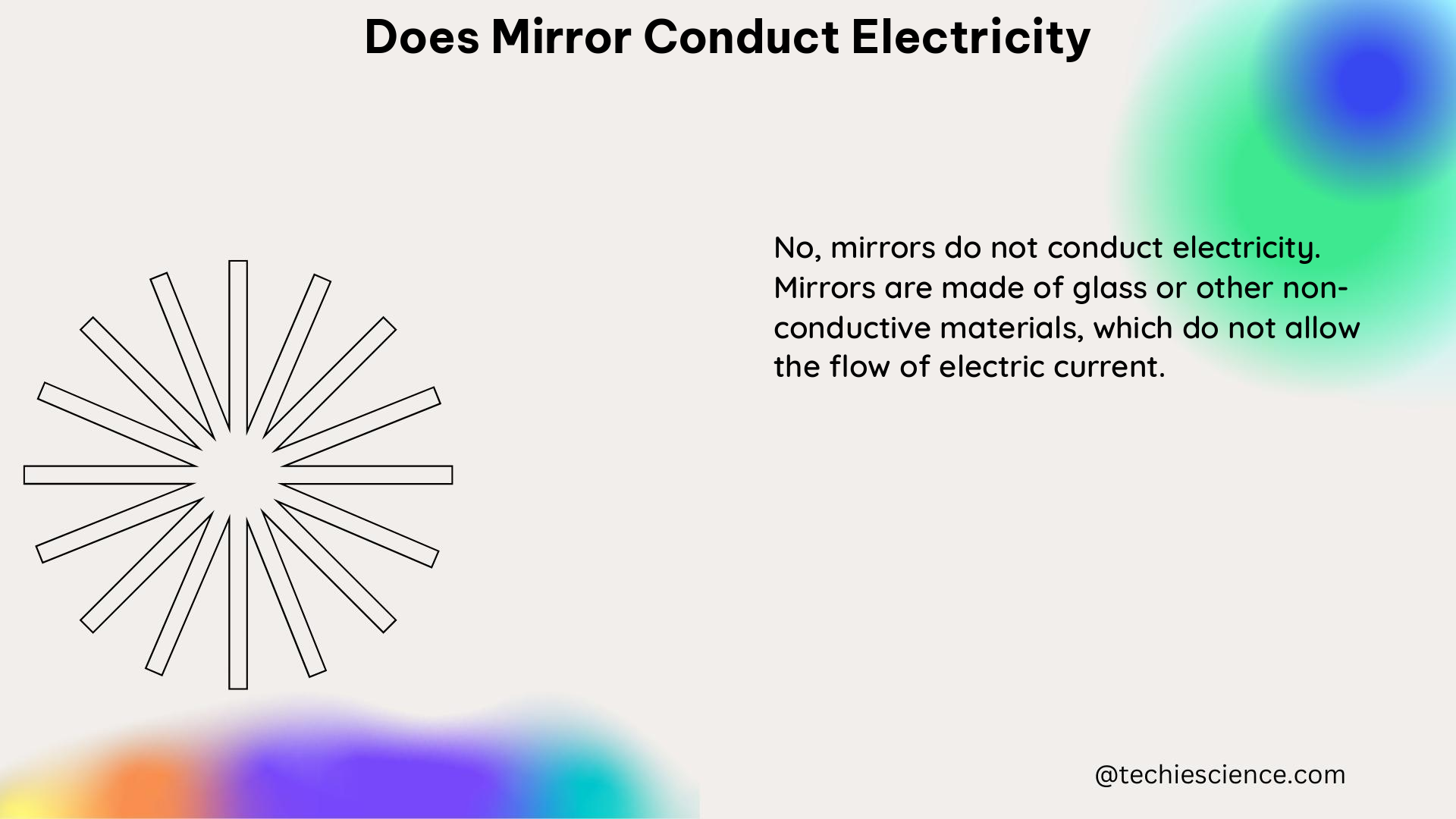Mirrors are primarily designed for reflection, and they do not conduct electricity in the same way that metals do. However, mirrors are often made with a metal coating, such as silver or aluminum, which are good conductors of electricity. The conductivity of the mirror is not its primary function, and it is not the same as a metal conductor.
Understanding the Conductivity of Mirrors
The conductivity of a mirror can be measured in terms of its electrical resistance, which is the opposition to the flow of electric current. The resistance (R) of a conductor can be calculated using the formula:
R = ρ(L/A)
Where:
– ρ (rho) is the resistivity of the material
– L is the length of the conductor
– A is the cross-sectional area of the conductor
However, for mirrors, this measurement is not typically performed or reported, as it is not a relevant property for their primary function.
Factors Affecting the Conductivity of Mirrors
-
Metal Coating: Mirrors are often coated with a thin layer of metal, such as silver or aluminum, which can conduct electricity. The thickness and quality of the metal coating can affect the overall conductivity of the mirror.
-
Substrate Material: The material used as the substrate for the mirror can also impact its conductivity. Common substrate materials include glass, plastic, or metal. Glass and plastic substrates have higher electrical resistance compared to metal substrates.
-
Defects and Impurities: Any defects or impurities in the metal coating or the substrate material can alter the conductivity of the mirror. These imperfections can create localized areas of higher or lower resistance, affecting the overall conductivity.
-
Temperature: The conductivity of metals, including the metal coating on mirrors, can be influenced by temperature. As the temperature increases, the conductivity of the metal generally improves due to increased electron mobility.
Measuring the Conductivity of Mirrors
As mentioned earlier, the conductivity of mirrors is not typically measured or reported, as it is not a primary concern for their intended use. However, in some specialized applications, such as the development of electrochromic mirrors or the use of mirrors in electromagnetic shielding, the conductivity of the mirror may be a relevant property.
In such cases, the conductivity of the mirror can be measured using various techniques, including:
- Four-Point Probe Measurement: This method involves placing four equally spaced probes on the surface of the mirror and applying a known current through the outer probes. The voltage drop between the inner probes is then measured, and the sheet resistance (Rs) can be calculated using the formula:
Rs = (π/ln 2) * (V/I)
Where:
– V is the voltage drop between the inner probes
– I is the current flowing through the outer probes
-
Van der Pauw Measurement: This technique is used to measure the sheet resistance of thin, uniform films, including mirror coatings. It involves placing four contacts at the edges of the sample and applying a current through two contacts while measuring the voltage drop across the other two.
-
Eddy Current Measurement: This non-destructive method uses an alternating magnetic field to induce eddy currents in the mirror’s conductive coating. The changes in the eddy currents can be used to estimate the conductivity of the mirror.
It’s important to note that the conductivity of mirrors is not a primary concern for their typical use, and these measurement techniques are more commonly employed in specialized applications where the mirror’s electrical properties are of interest.
Practical Implications of Mirror Conductivity

While the conductivity of mirrors is not their primary function, it can have some practical implications in certain scenarios:
-
Electromagnetic Shielding: Mirrors with conductive coatings can be used as part of electromagnetic shielding systems, as they can help block or attenuate electromagnetic radiation. This is particularly relevant in applications where mirrors are used in sensitive electronic environments.
-
Electrochromic Mirrors: Some specialized mirrors, known as electrochromic mirrors, use an electrically-driven reversible redox reaction to change their reflectivity. In these mirrors, the conductivity of the coatings plays a crucial role in the electrochemical processes that enable the variable reflectance.
-
Electrostatic Discharge (ESD) Protection: In environments where static electricity buildup can be a concern, such as clean rooms or electronics manufacturing facilities, conductive mirrors can help dissipate static charges and mitigate the risk of ESD-related damage.
-
Lighting and Heating Applications: The conductive properties of mirror coatings can be leveraged in specialized applications, such as using mirrors as heating elements or as part of lighting systems that require electrical conductivity.
It’s important to note that while these practical implications exist, the conductivity of mirrors is not a primary design consideration for most common mirror applications, such as in households, vehicles, or general optical systems.
Conclusion
In summary, while mirrors may have a metal coating that can conduct electricity, the conductivity is not the primary function of a mirror, and measurable data on this property is not typically reported or relevant for their use. The conductivity of mirrors can be measured using various techniques, but it is primarily relevant in specialized applications where the electrical properties of the mirror are of importance, such as in electromagnetic shielding, electrochromic mirrors, or ESD protection systems.
References:
– Practical Aspects of Mirror Usage in Optical Systems for Biology
– Mirror Point
– Electrical Conductivity of Mirrors
– Can Mirrors Catch Lightning?
– Electrical Resistance of Mirrors
Hi, I’m Akshita Mapari. I have done M.Sc. in Physics. I have worked on projects like Numerical modeling of winds and waves during cyclone, Physics of toys and mechanized thrill machines in amusement park based on Classical Mechanics. I have pursued a course on Arduino and have accomplished some mini projects on Arduino UNO. I always like to explore new zones in the field of science. I personally believe that learning is more enthusiastic when learnt with creativity. Apart from this, I like to read, travel, strumming on guitar, identifying rocks and strata, photography and playing chess.